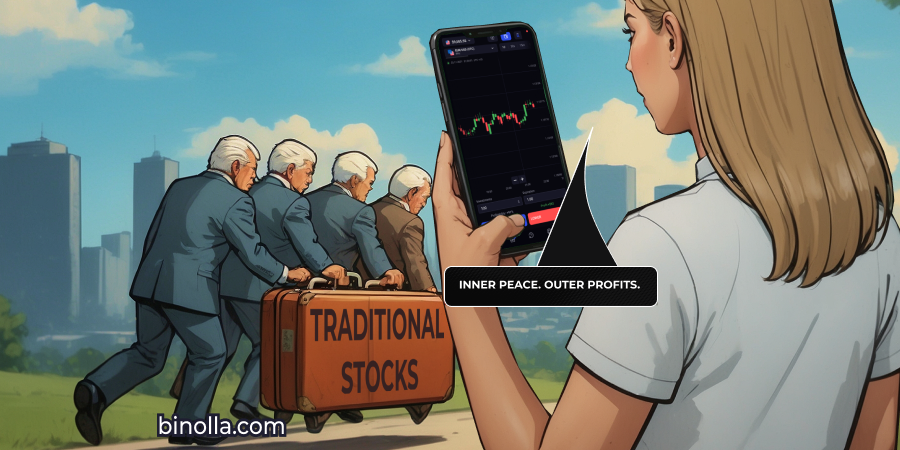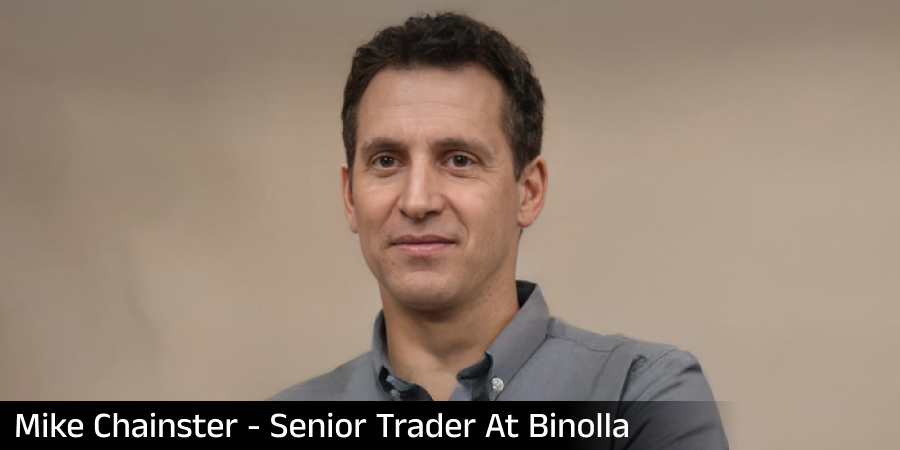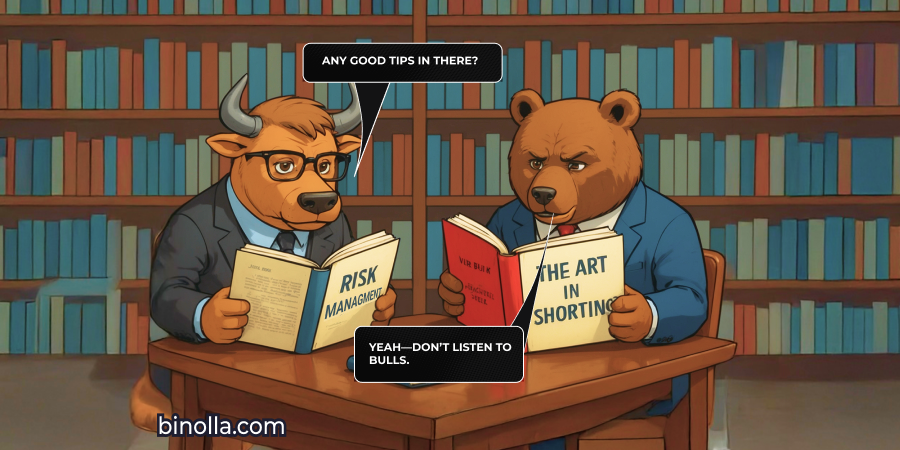How to Trade in the Financial Markets: An Ultimate Guide

Financial market trading is an opportunity to start a brand new career in the world of big money and make wealth by buying and selling various types of assets. While trading stocks, futures, cryptocurrencies, Forex, digital options, or other financial instruments may seem difficult and be the prerogative of professional economists and investors, nowadays, everyone can become a trader thanks to innovative technologies of chart analysis. If you are eager to start, here is a detailed guide on how to trade financial markets. To place your first trade at Binolla, create an account.
Contents
- 1 Trading Basics
- 2 How to Trade in the Financial Markets
- 3 Creating a Trading Journal
- 4 Trading or Investing?
- 5 Practice trading on the demo account!
- 6 An Example of Digital Options Trading
- 7 An Example of Forex Trading
- 8 Buying a Stock: A Common Example
- 9 How to Trade Cryptocurrency CFDs: A Basic Example
- 10 What to Look at When Trading Financial Markets
- 11 How to Trade in Financial Markets: Tips and Tricks
- 12 Final Words
- 13 FAQ
Trading Basics
First things first. Before digging deeper, it would be a good idea to define what trading is. In general, this is a process of buying and selling various financial instruments, aiming to make money on their price difference. There are thousands of various assets that you can pick for trading, which makes this journey even more attractive. Here are the most popular groups of instruments that most market participants use in their everyday trading routine.
- Forex currency pairs. Forex, aka foreign exchange, is a marketplace where banks and other huge players exchange currencies in order to conduct international commercial activities. Before the development of modern technologies, Forex was available for various financial institutions and companies only. Nowadays, this interbank market is accessible to a lot of participants, including retail traders and investors. The idea of Forex trading is to buy a currency against another when it is cheaper and sell it when it becomes more expensive. FX market trading is available 24/5;
- Digital Options. This is a financial derivative that allows you to buy a contract with a particular underlying asset like Forex, stocks, cryptocurrencies, etc. The idea is to predict the direction of price movement for a given interval. Digital options are considered the easiest instrument for beginners to start;
- Stocks. This is one of the most popular and oldest financial markets that allows you to buy a small part of a company. You can also buy a major part of a company by purchasing a controlling stake. For traders, the stock market is the opportunity to buy and sell shares and to profit from their price differences. For investors, stocks are valuable for offering dividends;
- Commodities. Traders often choose commodities for their volatility and liquidity. Those are physical goods like gold, iron, oil, natural gas and others;
- Cryptocurrencies. These are relatively new types of assets that are based on cutting-edge blockchain technology. Cryptocurrencies are numerous. Nowadays, you can count thousands of those digital assets. The most popular are Bitcoin, Litecoin, Ethereum, Doge, etc.
How to Trade in the Financial Markets
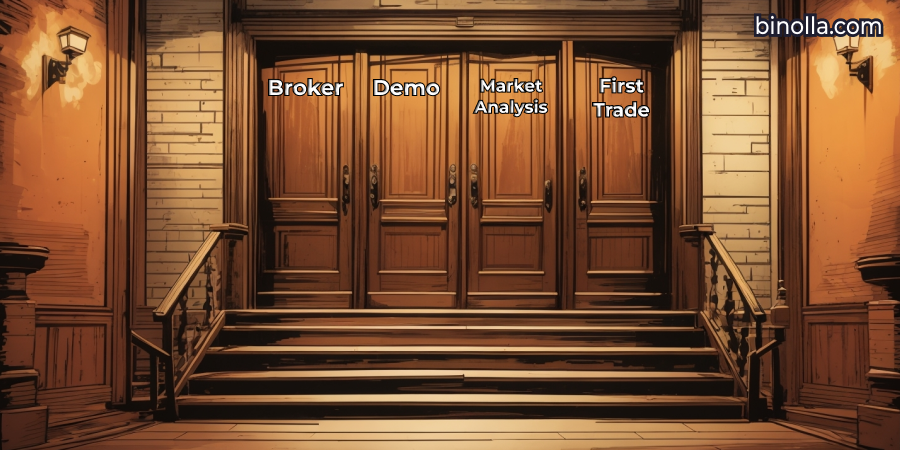
To start trading in the financial markets, you don’t need to have access to all those exchanges or interbank Forex markets directly. Nowadays, financial brokers provide traders with all they need to trade and analyze prices. Here is a step-by-step guide on how to make your first trade and build your own way in the financial markets.
Choose a Brokerage Company
Picking a platform is one of the most important things in trading. You need to find a reliable and regulated company that provides all the necessary analysis tools, various types of charts, bonuses, leverage, and other key advantages.
Try Your Skills on Demo
Before placing your first trade for real money, it would be a good idea to hone your skills in demo mode. This is a special type of account that allows you to use virtual money and trade with it as long as you wish. A demo mode is a great opportunity to adapt to the interface, test your strategies, get used to various analysis tools, etc.
Choose Your Financial Instruments and Assets
The next important step is to choose a trading asset and a financial instrument. Traders have access to a broad range of contracts and derivatives nowadays, including digital options, Forex CFDs, stocks, and many more. Before picking the right one, you should learn more about its basic principles and discover the factors that affect a particular asset.
Analyze the Asset
Now that you have one or a couple of assets in mind, you can watch the chart and look through macroeconomic data. Use a strategy to find entry points and set stop-losses/take-profits if you are trading FX or stocks. Those who buy digital options should also define expiration.
Make a Trade
Finally, you are ready to place your first trade in the financial markets. The last step that you need to take is to set an investment amount. Keep in mind that according to the money management rules, it is recommended to put no more than 1-5% at risk.
Creating a Trading Journal
This how-to-trade-financial-markets guide wouldn’t be complete without mentioning trading journals and how to use them. A trading journal is a kind of diary that most traders use to evaluate their performance over time. Such a diary is important when you are looking for opportunities to improve your trading. Here is a list of the key advantages of using trading journals or adding them to your trading routine if you still have none:
- It allows you to gain insight into your trading to reveal strong and weak points;
- Trading journals provide a strong tool for helping traders manage their money;
- With such a diary, you can pick the best strategy after analyzing your trading performance.
Keep in mind that simply creating this kind of journal is useless unless you add only valuable information. This may include:
- Reasons to trade;
- Conviction;
- Trading signals that you use;
- Assets and financial instruments that you buy or sell;
Also, you can add your trading results and even some key points after you work on your mistakes.
Trading or Investing?
While the line between both has become very thick recently, the difference between trading and investing still exists. Trading is when you don’t own an asset. You simply buy a kind of contract for it. The idea of trading is to try to find which asset is cheaper and purchase it in order to sell it in the future when the price becomes higher.
Unlike trading, investing’s main goal is to hold an asset for as long as possible. The idea is to collect dividends that are paid by companies to their stakeholders. Even with this in mind, investors also tend to earn on the price difference. They may buy cheaper stocks and sell them once the price reaches their targets.
An Example of Digital Options Trading
Digital options are believed to be the simplest financial instruments for traders. They offer limited risks, and they do not require traders to plan stop-losses and take-profits. Here is an example of how to buy a fixed-time contract:
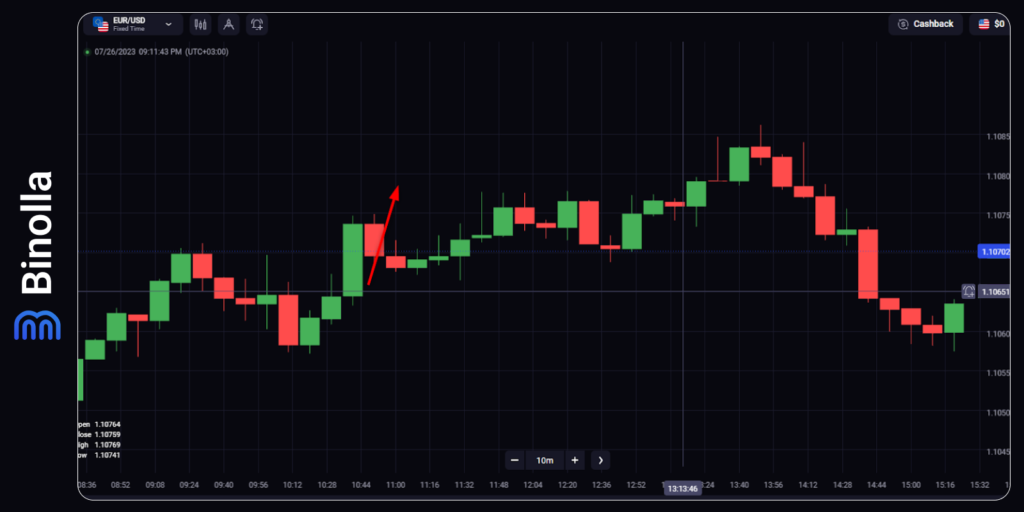
Assume that a trader wants to buy a Higher contract on EUR/USD with 1.1065 as a strike price. He chooses the 5-minute expiration. The trader invests $10 in this contract with a 90% payout. Let’s imagine that the trader was right in his forecasts and the price went higher. He or she earns $9 and gets his or her $10 investment back.
An Example of Forex Trading
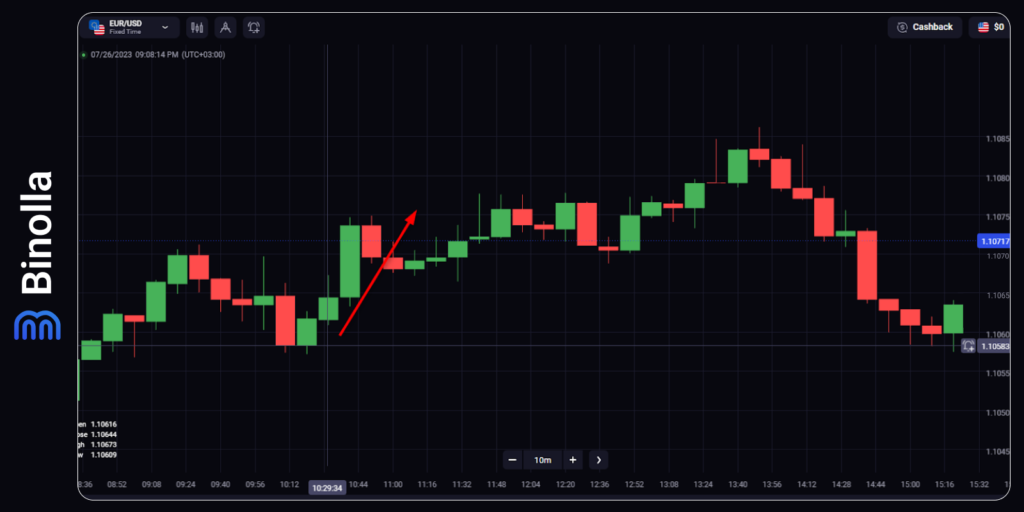
Say the EUR/USD price is 1.0900. A trader thinks that the currency pair is likely to grow. He or she decides to buy EUR/USD at a given price putting $10 at risk (with 0.1 lot, which is equal to $1 per pip). The price goes higher and hits 1.0920. The trader decides to close the position. He or she earns $20 and has his or her $10 back.
Buying a Stock: A Common Example
Let’s say you buy Apple stock for $195, expecting the price to rise over time. AAPL quotes go upwards within a week and hit $200. You decide to close your position and put $5 into your pocket as a profit. Keep in mind that you can use leverage and buy more stocks, like 10 shares, for instance. The eventual profit will be multiplied by this amount in this case.
How to Trade Cryptocurrency CFDs: A Basic Example
Assume that you have done research and have come to the conclusion that BTC/USD is going to plummet from 29,000. You decide to sell the CFD for this cryptocurrency pair (using leverage with 0.1 lot, where 1 pip is equal to $1). The price goes down over time and hits 28,940. Your profit in this case would be $60.
What to Look at When Trading Financial Markets
Each asset has its own features and data that may bring volatility. Here is the list of the most popular financial instruments and their drivers:
- Forex. The currency pairs are mostly influenced by central banks’ decisions. Other important drivers may include inflation data, labor market, trade balance, GDP, etc;
- Stocks. Along with macroeconomic data, shares are influenced by company data releases. The most important of them are earnings;
- Cryptocurrencies. They correlate with other assets when it comes to economic data. However, there is a huge layer of data that drives cryptocurrencies prices, including general blockchain technology news, regulatory and adoption, particular blockchain events and updates, etc.
How to Trade in Financial Markets: Tips and Tricks
Trading is not simple. There are plenty of factors that should be considered before you will be able to make money consistently. Here are some recommendations from the experts that may help you tip the balance:
- Always have a trading plan. Along with a strategy that defines entry points, traders are required to have a trading plan that includes various aspects, including entries, exits (for Forex and stocks traders), money management, and other key factors;
- Never stop learning. Even if you have a trading strategy that works, you should never stop learning, as you can improve it in the future or even switch to a more profitable one;
- Treat trading like a business. If you want to trade for a living, you should treat it like your personal business, with a real commitment;
- Use technologies. Wherever you go, you can always stay with the market by using a mobile device to predict price fluctuations and even open trades;
- Risk only what you can afford to lose. Don’t invest more than you can lose as it may negatively impact your trading results. Traders who put more money at risk often have fears of losing it and, as a result, they lose opportunities or simply are afraid to open trades;
- Never lose confidence. Psychology is a very important part of trading. Therefore, you should always stay confident in what you do. All your failures in the financial markets should be taken as experience and not your personal losses;
- Use stop-losses (in Forex and stocks). Protecting your positions from higher risks is a good idea. Once you place a stop-loss, you can be sure that the position will be closed at a particular level if your predictions are wrong. Also, you shouldn’t move stop-losses trying to save what’s not yours anymore. Once a stop-loss order triggers, you will find another trading opportunity.
Final Words
Now that you know how to trade on financial markets, you can start right away. Keep in mind that this path has both ups and downs, and you should learn how to overcome the obstacles in order to succeed. Remember that not all of your trades will be profitable, but your main goal is to increase your balance over time.
One of the key components of success is a systematic approach to trading. You can start a trading journal, use a well-developed trading plan, and keep an eye on your balance in order to make trading your career.
FAQ

What Is the Best Financial Market to Trade?
There is no financial market that can be considered the best, as all of them offer some advantages to traders. Forex, for instance, allows you to trade 24/5, while stock is available during special sessions only. When it comes to financial instruments, digital options are considered the best for beginners because of their simplicity. However, you can consider Forex and stock trading as well, as they allow you to let your profit grow instead of cutting it at the moment of contract expiration.
Is Financial Trading Hard?
Yes, it is. To make it your career, you will have to learn a lot about the financial markets, instruments, types of analysis, and many other aspects. It will take time to understand how trading works and how to use strategies in order to increase your chances of earning money.
How Fast Can You Learn Trading?
It depends solely on how fast you can learn all you need to place your first trade. If you are ready to spend time discovering trading and its features and have enough time to practice, you will be able to cover this distance quickly. Some traders manage to place their first trades within the first week with a very simple strategy at hand.
